air conditioning Citroen DS3 RHD 2015 1.G Owner's Manual
[x] Cancel search | Manufacturer: CITROEN, Model Year: 2015, Model line: DS3 RHD, Model: Citroen DS3 RHD 2015 1.GPages: 387, PDF Size: 12.26 MB
Page 12 of 387
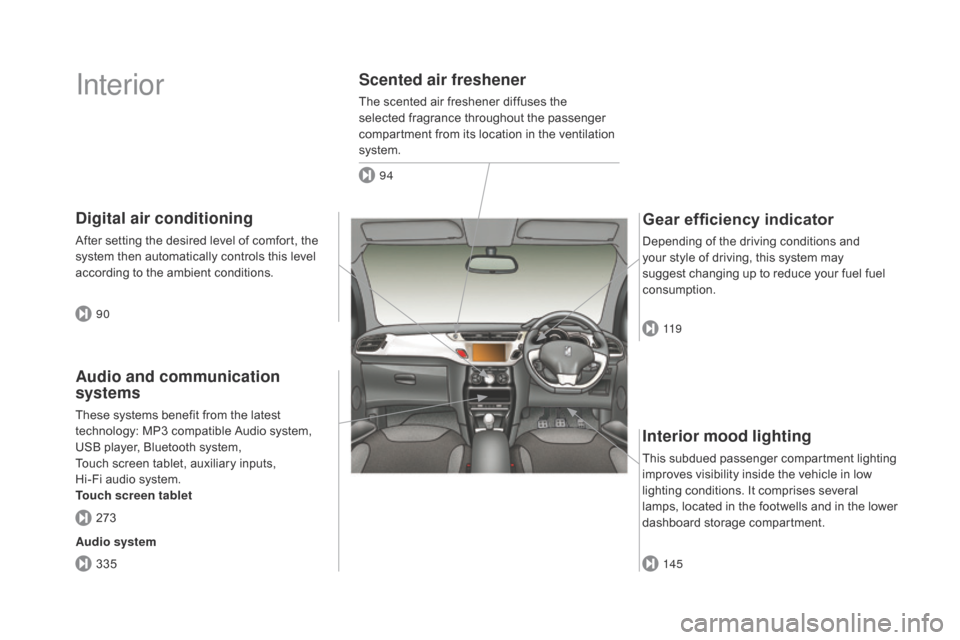
Interior
Interior mood lighting
Thisô subduedô passengerô compartmentô lightingô improves ô visibility ô inside ô the ô vehicle ô in ô low ô
l
ighting ô conditions. ô It ô comprises ô several ô
l
amps, ô located ô in ô the ô footwells ô and ô in ô the ô lower ô
d
ashboard
ô s
torage
ô c
ompartment.
Gear efficiency indicator
Dependingô ofô theô drivingô conditionsô andô your ô style ô of ô driving, ô this ô system ô may ô
s
uggest ô changing ô up ô to ô reduce ô your ô fuel ô fuel ô
c
onsumption.
Scented air freshener
Theô scentedô airô freshenerô diffusesô theô selected ô fragrance ô throughout ô the ô passenger ô
c
ompartment ô from ô its ô location ô in ô the ô ventilation ô
s
ystem.
digital air conditioning
Afterô settingô theô desiredô levelô ofô comfort,ô theô system ô then ô automatically ô controls ô this ô level ô
a
ccording ô to ô the ô ambient ô conditions.
145 11 9
94
90
335 273
Audio and communication
systems
Theseô systemsô benefitô fromô theô latestô t echnology: ô MP3 ô compatible ô Audio ô system, ô
U
SB ô player, ô Bluetooth ô system, ô
Touchô screen
ô tablet, ô auxiliary ô inputs, ô
Hi-Fi
ô audio ô system.
Touch screen tablet
Audio system
Page 14 of 387
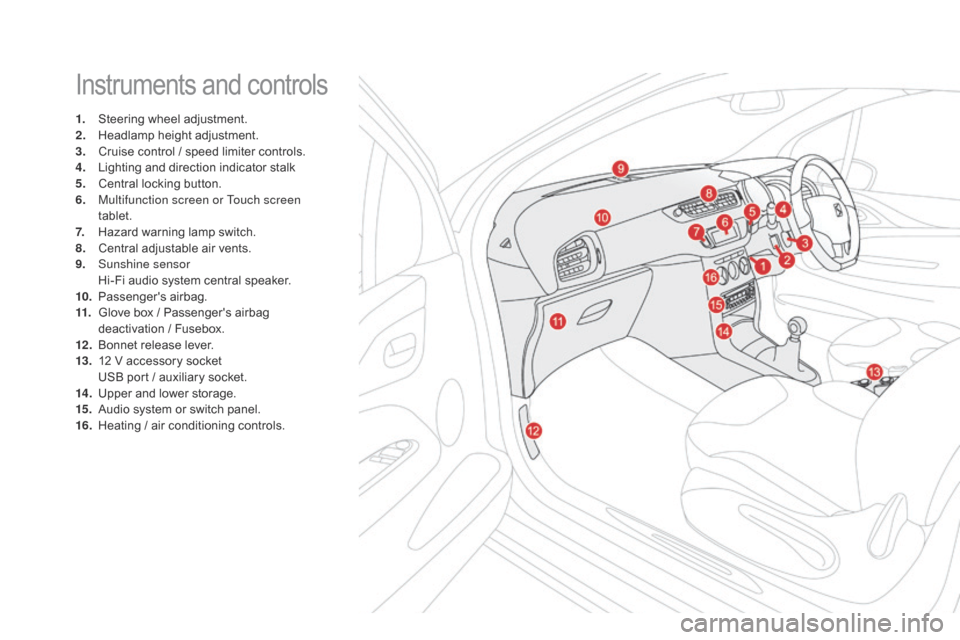
Instrumentsô andô controls
1.ô Steeringô wheel ô adjustment.
2.ô H eadlamp ô height ô adjustment.
3.
ô C
ruise ô control ô / ô speed ô limiter ô controls.
4.
ô L
ighting ô and ô direction ô indicator ô stalk
5.
ô C
entral ô locking ô button.
6.
M
ultifunction screen or Touch screen
tablet.
7.
ô H
azard ô warning ô lamp ô switch.
8.
ô C
entral ô adjustable ô air ô vents.
9.
S
unshine sensor
ô H
i-Fi ô audio ô system ô central ô speaker.
10.
ô P
assenger's
ô ai
rbag.
11.
ô G
love ô box ô / ô Passenger's ô airbag ô
d
eactivation ô / ô Fusebox.
12 .
ô B
onnet ô release ô lever.
13.
ô 1
2 ô V ô accessory ô socket
ô U
SB ô port ô / ô auxiliary ô socket.
14 .
ô U
pper ô and ô lower ô storage.
15.
ô A
udio ô system ô or ô switch ô panel.
16.
ô H
eating ô / ô air ô conditioning ô controls.
Page 16 of 387
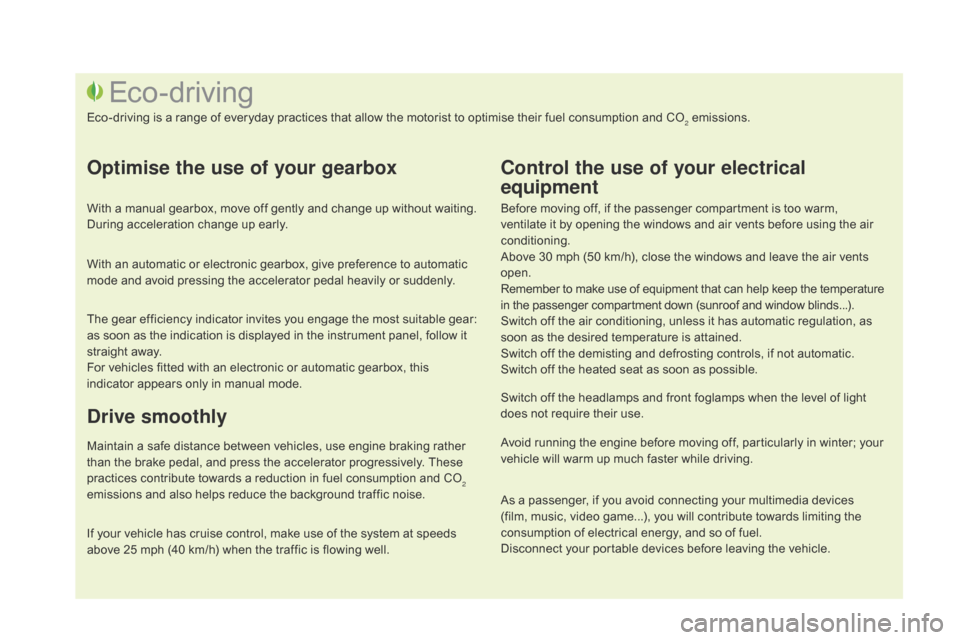
Beforeô movingô off,ô ifô theô passengerô compartmentô isô tooô warm,ô ventilate ô it ô by ô opening ô the ô windows ô and ô air ô vents ô before ô using ô the ô air ô
c
onditioning.
Above
ô 30 ô mph ô (50 ô km/h), ô close ô the ô windows ô and ô leave ô the ô air ô vents ô
ope
n.
Remember
ô to ô make ô use ô of ô equipment ô that ô can ô help ô keep ô the ô temperature
ô i
n ô the ô passenger ô compartment ô down ô (sunroof ô and ô window ô blinds...).
Switch
ô off ô the ô air ô conditioning, ô unless ô it ô has ô automatic ô regulation, ô as ô
s
oon ô as ô the ô desired ô temperature ô is ô attained.
Switch
ô off ô the ô demisting ô and ô defrosting ô controls, ô if ô not ô automatic.
Switch
ô off ô the ô heated ô seat ô as ô soon ô as ô possible.
Switch
ô off ô the ô headlamps ô and ô front ô foglamps ô when ô the ô level ô of ô light ô
d
oes ô not ô require ô their ô use.
Avoid
ô running ô the ô engine ô before ô moving ô off, ô particularly ô in ô winter; ô your ô
v
ehicle ô will ô warm ô up ô much ô faster ô while ô driving.
Eco-driving
Eco-drivingô isô aô rangeô ofô everydayô practicesô thatô allowô theô motoristô toô optimiseô theirô fuelô consumptionô andô CO2ô emissions.
Optimise the use of your gearbox
Withô aô manualô gearbox,ô moveô offô gentlyô andô changeô upô withoutô waiting.ô During ô acceleration ô change ô up ô early.
With
ô an ô automatic ô or ô electronic ô gearbox, ô give ô preference ô to ô automatic ô
m
ode ô and ô avoid ô pressing ô the ô accelerator ô pedal ô heavily ô or ô suddenly.
The
ô gear ô efficiency ô indicator ô invites ô you ô engage ô the ô most ô suitable ô gear: ô
a
s ô soon ô as ô the ô indication ô is ô displayed ô in ô the ô instrument ô panel, ô follow ô it ô
s
traight ô away.
For
ô vehicles ô fitted ô with ô an ô electronic ô or ô automatic ô gearbox, ô this ô
i
ndicator ô appears ô only ô in ô manual ô mode.
drive smoothly
Maintainô aô safeô distanceô betweenô vehicles,ô useô engineô brakingô ratherô than ô the ô brake ô pedal, ô and ô press ô the ô accelerator ô progressively. ô These ô
p
ractices ô contribute ô towards ô a ô reduction ô in ô fuel ô consumption ô and ô CO
2
emissions
ô
and
ô
also
ô
helps
ô
reduce
ô
the
ô
background
ô
traffic
ô
noise.
Control the use of your electrical
equipment
Ifô yourô vehicleô hasô cruiseô control,ô makeô useô ofô theô systemô atô speedsô a bove ô 25 ô mph ô (40 ô km/h) ô when ô the ô traffic ô is ô flowing ô well.As
ô a ô passenger, ô if ô you ô avoid ô connecting ô your ô multimedia ô devices ô
(
film, ô music, ô video ô game...), ô you ô will ô contribute ô towards ô limiting ô the ô c
onsumption ô of ô electrical ô energy, ô and ô so ô of ô fuel.
Disconnect ô your ô portable ô devices ô before ô leaving ô the ô vehicle.
Page 87 of 387
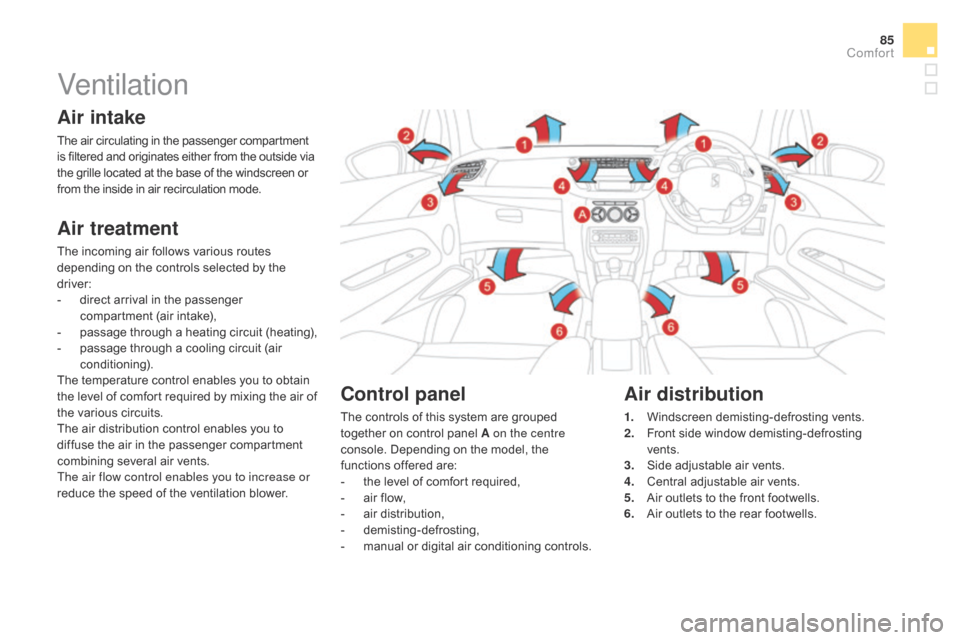
85
Ventilation
Air intake
Theô airô circulatingô inô theô passengerô compartmentô is ô filtered ô and ô originates ô either ô from ô the ô outside ô viaô t
he ô grille ô located ô at ô the ô base ô of ô the ô windscreen ô or
ô f
rom ô the ô inside ô in ô air ô recirculation ô mode.
Air treatment
Theô incomingô airô followsô variousô routesô depending ô on ô the ô controls ô selected ô by ô the ô
d
river:
-
ô
d
irect ô arrival ô in ô the ô passenger ô
c
ompartment ô (air ô intake),
-
ô
p
assage ô through ô a ô heating ô circuit ô (heating),
-
ô
p
assage ô through ô a ô cooling ô circuit ô (air ô
c
onditioning).
The
ô temperature ô control ô enables ô you ô to ô obtain ô
t
he ô level ô of ô comfort ô required ô by ô mixing ô the ô air ô of ô
t
he ô various ô circuits.
The
ô air ô distribution ô control ô enables ô you ô to ô
d
iffuse ô the ô air ô in ô the ô passenger ô compartment ô
c
ombining ô several ô air ô vents.
The air flow control enables you to increase or
reduce
ô the ô speed ô of ô the ô ventilation ô blower.
Control panel
Theô controlsô ofô thisô systemô areô groupedô together ô on ô control ô panel ô A on the centre
console.
ô Depending ô on ô the ô model, ô the ô
f
unctions ô offered ô are:
-
ô
t
he ô level ô of ô comfort ô required,
-
ô
a
ir ô flow,
-
ô
a
ir ô distribution,
-
ô d
emisting-defrosting,
-
ô
m
anual ô or ô digital ô air ô conditioning ô controls.
Air distribution
1.ô Windscreenô demisting-defrostingô v ents.
2.ô F ront ô side ô window ô demisting-defrosting ô
ve
nts.
3.
ô S
ide ô adjustable ô air ô vents.
4.
ô C
entral ô adjustable ô air ô vents.
5.
ô A
ir ô outlets ô to ô the ô front ô footwells.
6.
ô A
ir ô outlets ô to ô the ô rear ô footwells.
Comfort
Page 88 of 387
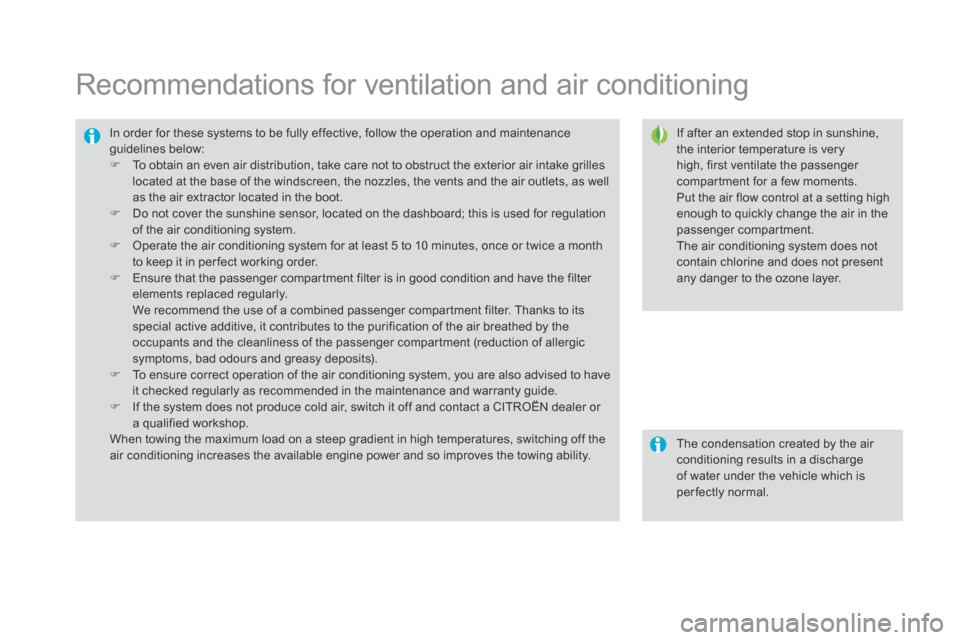
Recommendationsô forô ventilationô andô airô conditioning
Ifô afterô anô extendedô stopô inô sunshine,ô the ô interior ô temperature ô is ô very ô
h
igh, ô first ô ventilate ô the ô passenger ô
c
ompartment ô for ô a ô few ô moments.
Put
ô the ô air ô flow ô control ô at ô a ô setting ô high ô
e
nough ô to ô quickly ô change ô the ô air ô in ô the ô
p
assenger
ô c
ompartment.
The
ô air ô conditioning ô system ô does ô not ô
c
ontain ô chlorine ô and ô does ô not ô present ô
a
ny ô danger ô to ô the ô ozone ô layer.
In
ô
order
ô
for
ô
these
ô
systems
ô
to
ô
be
ô
fully
ô
effective,
ô
follow
ô
the
ô
operation
ô
and
ô
maintenance
ô g
uidelinesô belo
w:
F
ô
T
o
ô
obtain
ô
an
ô
even
ô
air
ô
distribution,
ô
take
ô
care
ô
not
ô
to
ô
obstruct
ô
the
ô
exterior
ô
air
ô
intake
ô
grilles
ô
l
ocated
ô
at
ô
the
ô
base
ô
of
ô
the
ô
windscreen,
ô
the
ô
nozzles,
ô
the
ô
vents
ô
and
ô
the
ô
air
ô
outlets,
ô
as
ô
well
ô
a
s
ô
the
ô
air
ô
extractor
ô
located
ô
in
ô
the
ô
boot.
F
ô
D
o
ô
not
ô
cover
ô
the
ô
sunshine
ô
sensor,
ô
located
ô
on
ô
the
ô
dashboard;
ô
this
ô
is
ô
used
ô
for
ô
regulation
ô
o
f
ô
the
ô
air
ô
conditioning
ô
system.
F
ô
O
perate
ô
the
ô
air
ô
conditioning
ô
system
ô
for
ô
at
ô
least
ô
5
ô
to
ô
10
ô
minutes,
ô
once
ô
or
ô
twice
ô
a
ô
month
ô
t
o
ô
keep
ô
it
ô
in
ô
per fect
ô
working
ô
order.
F
ô
E
nsure
ô
that
ô
the
ô
passenger
ô
compartment
ô
filter
ô
is
ô
in
ô
good
ô
condition
ô
and
ô
have
ô
the
ô
filter
ô
e
lements
ô
replaced
ô
regularly.
ô W
e
ô
recommend
ô
the
ô
use
ô
of
ô
a
ô
combined
ô
passenger
ô
compartment
ô
filter.
ô
Thanks
ô
to
ô
its
ô
s
pecial
ô
active
ô
additive,
ô
it
ô
contributes
ô
to
ô
the
ô
purification
ô
of
ô
the
ô
air
ô
breathed
ô
by
ô
the
ô
o
ccupants
ô
and
ô
the
ô
cleanliness
ô
of
ô
the
ô
passenger
ô
compartment
ô
(reduction
ô
of
ô
allergic
ô
s
ymptoms,
ô
bad
ô
odours
ô
and
ô
greasy
ô
deposits).
F
ô
T
o
ô
ensure
ô
correct
ô
operation
ô
of
ô
the
ô
air
ô
conditioning
ô
system,
ô
you
ô
are
ô
also
ô
advised
ô
to
ô
have
ô
i
t
ô
checked
ô
regularly
ô
as
ô
recommended
ô
in
ô
the
ô
maintenance
ô
and
ô
warranty
ô
guide.
F
ô
I
f
ô
the
ô
system
ô
does
ô
not
ô
produce
ô
cold
ô
air,
ô
switch
ô
it
ô
off
ô
and
ô
contact
ô
a
ô
CITROûN
ô
dealer
ô
or
ô
a
ô
qualified
ô
workshop.
When
ô
towing
ô
the
ô
maximum
ô
load
ô
on
ô
a
ô
steep
ô
gradient
ô
in
ô
high
ô
temperatures,
ô
switching
ô
off
ô
the
ô
a
ir
ô
conditioning
ô
increases
ô
the
ô
available
ô
engine
ô
power
ô
and
ô
so
ô
improves
ô
the
ô
towing
ô
ability. The
ô condensation ô created ô by ô the ô air ô
c
onditioning ô results ô in ô a ô discharge ô
o
f ô water ô under ô the ô vehicle ô which ô is ô
p
er fectly ô normal.
Page 89 of 387
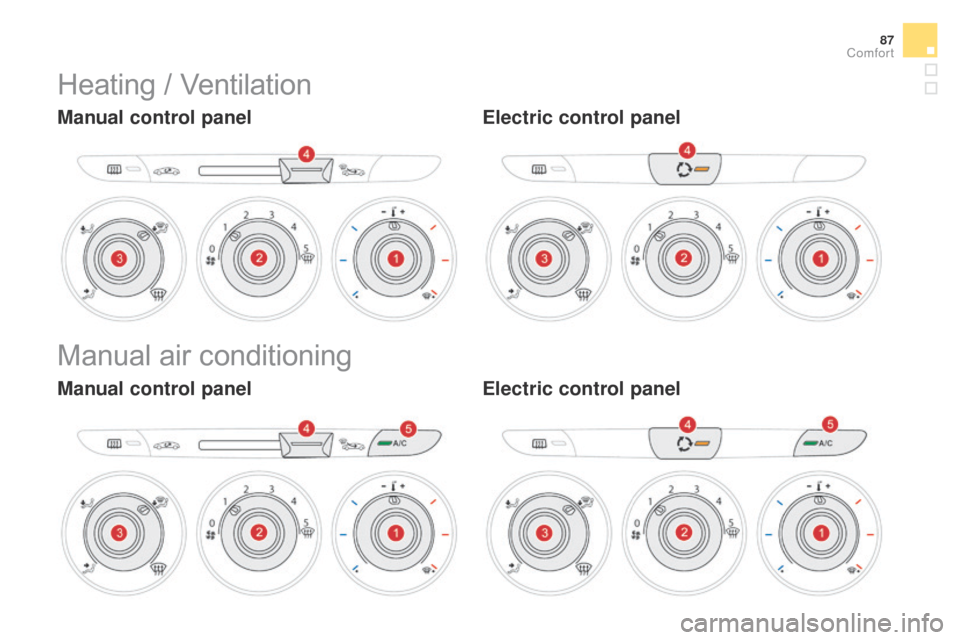
87
Heatingô /ô Ventilation
Manual control panelElectric control panel
Manualô airô conditioning
Manual control panel Electric control panel
Comfort
Page 90 of 387

Theô heatingô /ô ventilationô orô airô conditioningô systemsô operatesô withô theô engineô running,ô asô wellô asô inô STOPô modeô withô Stopô &ô Start.
1. Temperature adjustment
Fô Turnô the ô dial ô from ô blue ô (
cold) ô to ô red ô (hot) ô to ô adjust ô
t
he ô temperature ô to ô your ô
r
equirements.
2. Air flow adjustment
Fô Turn ô the ô dial ô from ô position ô 1
to position 5 to obtain a
comfortable
ô air ô flow.
F
I
f you place the air flow control
in position 0
ô (deactivation ô of ô the ô
s
ystem), ô the ô temperature ô is ô no ô
l
onger ô maintained ô at ô a ô comfortable ô
l
evel. ô However, ô a ô slight ô flow ô of ô air, ô
d
ue ô
t
o ô
t
he ô
m
ovement ô
o
f ô
t
he ô
v
ehicle, ô
c
an ô still ô be ô felt.
3. Air distribution adjustment
Windscreenô andô sideô windows.
W indscreen, ô side ô windows ô and ô
f
ootwells.
Footwells.
Central
ô and ô side ô vents.
The
ô air ô distribution ô can ô be ô
a
dapted ô by ô placing ô the ô dial ô
i
n ô an ô intermediate ô position.
4. Air intake / Air recirculation
Theô intakeô ofô exteriorô airô avoidsô theô formationô of ô mist ô on ô the ô windscreen ô and ô side ô windows.
The recirculation of interior air insulates the
passenger
ô compartment ô from ô exterior ô odours ô
a
nd ô smoke.
Return
ô to ô exterior ô air ô intake ô as ô soon ô as ô possible ô
t
o ô prevent ô deterioration ô of ô the ô air ô quality ô and ô
t
he ô formation ô of ô mist.
Manual control panel F
ô
M
ove ô the ô manual ô control ô to ô
t
he ô left ô to ô be ô in ô the ô "recycling ô
i
nterior ô air" ô position.
F
ô
M
ove ô the ô manual ô control ô to ô the ô
r
ight ô to ô return ô to ô the ô "fresh ô air ô
i
ntake" ô position.
Page 91 of 387

89
5. Air conditioning On / Off
Theô airô conditioningô isô designedô toô operate effectively in all seasons,
with
ô the ô windows ô closed.
Electric control panel
F
P
ress the button to recirculate
the
ô
interior
ô
air.
ô
The
ô
indicator
ô
l
amp
ô
comes
ô
on
ô
to
ô
confirm
ô
this.
F
ô
P
ress
ô
the
ô
button
ô
again
ô
to
ô
allow
ô
fresh
ô
air
ô
i
nto
ô
the
ô
passenger
ô
compartment.
ô
The
ô
i
ndicator
ô
lamp
ô
goes
ô
off
ô
to
ô
confirm
ô
this. It
ô
enables
ô
you ô to:
-
ô
l
ower
ô
the ô temperature, ô in ô summer,
-
ô
i
ncrease ô the ô effectiveness ô of ô the ô demisting ô
i
n
ô
winter, ô above ô 3 ô ô¯C.
Switching on
F Press the "A /C "ô button, ô the ô button's ô i
ndicator ô lamp ô comes ô on.
Switching off
F Press the "A /C "ô button ô again, ô the ô button's ô i
ndicator ô lamp ô goes ô off.
Switching
ô off ô may ô affect ô comfort ô levels ô
(
humidity,
ô c
ondensation).
The
ô air ô conditioning ô does ô not ô operate ô
w
hen ô the ô air ô flow ô adjustment ô control ô 2
is in position " 0".
To ô obtain ô cooled ô air ô more ô quickly, ô you ô
c
an use recirculation of interior air for
a ô few ô moments. ô Then ô return ô to ô fresh ô
a
ir ô intake.
Comfort
Page 92 of 387
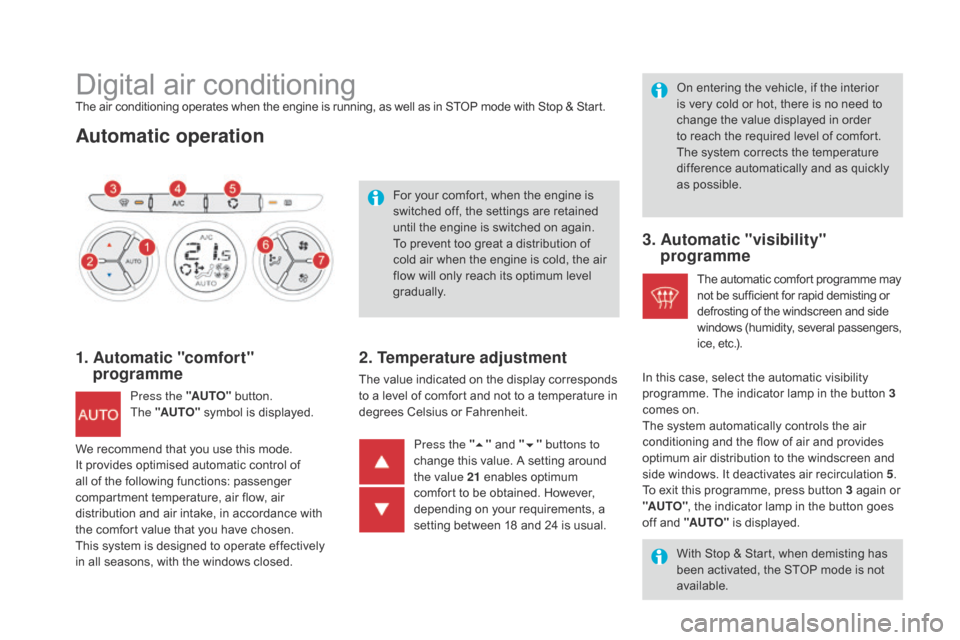
Digitalô airô conditioningTheô airô conditioningô operatesô whenô theô engineô isô running,ô asô wellô asô inô STOPô modeô withô Stopô &ô Start.
Automatic operation
1. Automatic "comfort" programme
Press the "AUTO"ô button. ô T
he "AUTO"ô symbol ô is ô displayed. For
ô your ô comfort, ô when ô the ô engine ô is ô
s
witched ô off, ô the ô settings ô are ô retained ô
u
ntil ô the ô engine ô is ô switched ô on ô again.
To ô prevent ô too ô great ô a ô distribution ô of ô
c
old ô air ô when ô the ô engine ô is ô cold, ô the ô air ô
f
low ô will ô only ô reach ô its ô optimum ô level ô
g
radually.
2. Temperature adjustment
Theô valueô indicatedô onô theô displayô correspondsô t
o ô a ô level ô of ô comfort ô and ô not ô to ô a ô temperature ô in ô
d
egrees ô Celsius ô or ô Fahrenheit. On
ô entering ô the ô vehicle, ô if ô the ô interior ô
i
s ô very ô cold ô or ô hot, ô there ô is ô no ô need ô to ô
c
hange ô the ô value ô displayed ô in ô order ô
t
o ô reach ô the ô required ô level ô of ô comfort. ô
T
he ô system ô corrects ô the ô temperature ô
d
ifference ô automatically ô and ô as ô quickly ô
a
s ô possible.
Press the " 5"
ô and ô "6 " buttons to
change
ô this ô value. ô A ô setting ô around ô
t
he value 21
ô
enables ô optimum ô
c
omfort ô to ô be ô obtained. ô However, ô
d
epending ô on ô your ô requirements, ô a ô
s
etting ô between ô 18 ô and ô 24 ô is ô usual.
3. Automatic "visibility" programme
Theô automaticô comfortô programmeô mayô n
ot ô be ô sufficient ô for ô rapid ô demisting ô orô d
efrosting ô of ô the ô windscreen ô and ô side
ô w
indows
ô (
humidity,
ô se
veral
ô p
assengers,
ô i
ce, ô etc.).
With
ô Stop ô & ô Start, ô when ô demisting ô has ô
b
een ô activated, ô the ô STOP ô mode ô is ô not ô
a
vailable.
In
ô
this
ô
case, ô select ô the ô automatic ô visibility ô
p
rogramme. ô The ô indicator ô lamp ô in ô the ô button ô 3
comes
ô
on.
The
ô
system ô automatically ô controls ô the ô air ô
c
onditioning ô and ô the ô flow ô of ô air ô and ô provides ô
o
ptimum
ô
air ô distribution ô to ô the ô windscreen ô and ô
s
ide
ô
windows. ô It ô deactivates ô air ô recirculation ô 5.
To
ô
exit
ô
this ô programme, ô press ô button ô 3 ô again ô or ô
"A
UTO" ,
ô
the ô indicator ô lamp ô in ô the ô button ô goes ô
o
ff
ô
and
ô
"AUTO"
ô
is ô displayed.
We
ô
recommend
ô
that
ô
you
ô
use
ô
this
ô
mode.
ô
I
t
ô
provides
ô
optimised
ô
automatic
ô
control
ô
of
ô
a
ll
ô
of
ô
the
ô
following
ô
functions:
ô
passenger
ô
c
ompartment
ô
temperature,
ô
air
ô
flow,
ô
air
ô
d
istribution
ô
and
ô
air
ô
intake,
ô
in
ô
accordance
ô
with
ô
t
he
ô
comfort
ô
value
ô
that
ô
you
ô
have
ô
chosen.
This
ô
system
ô
is
ô
designed
ô
to
ô
operate
ô
effectively
ô
i
n
ô
all
ô
seasons,
ô
with
ô
the
ô
windows
ô
closed.
Page 93 of 387

91
Itô isô possibleô toô adjustô oneô orô moreô functionsô manually ô while ô leaving ô the ô other ô functions ô in ô
a
utomatic ô mode.
The "AUTO"
ô
symbol ô switches ô off.
To
ô return ô to ô automatic ô mode, ô press ô the ô "AUTO"
button.
Manual override
4. Air conditioning on/off
Forô maximumô coolingô orô heatingô ofô theô c abin, ô it ô is ô possible ô to ô go ô beyond ô the ô
m
inimum ô 14 ô or ô maximum ô 28 ô values.
F
P
ress the blue button 2 until "LO"
is
ô displayed ô or ô the ô red ô button ô 2
until
"HI"
ô
is ô displayed. Press this button to switch off the air
conditioning.
Stopping
ô the ô air ô conditioning ô may ô cause
ô s
ome ô problems ô (humidity, ô misting).
5. Air intake / Air recirculation
Press this button for recirculation of
the
ô interior ô air. ô The ô air ô recirculation ô
s
ymbol
ô 5
ô is ô displayed.
Avoid
ô prolonged ô recirculation ô of ô
i
nterior ô air ô (risk ô of ô condensation ô or ô
d
eterioration ô of ô the ô air ô quality).
Switching
ô
to
ô
manual
ô
mode
ô
may
ô
not
ô
be
ô
s
uitable
ô
(temperature,
ô
humidity,
ô
odour,
ô
c
ondensation)
ô
and
ô
does
ô
not
ô
provide
ô
o
ptimum
ô c
omfort. Automatic
ô
operation
ô
of
ô
the
ô
air
ô
conditioning
ô
is
ô
r
esumed
ô
when
ô
the
ô
button
ô
is
ô
pressed
ô
again.
ô
The
ô
symbol
ô
"A /C "
ô
is
ô
displayed. Air
ô
recirculation ô enables ô the ô passenger ô
c
ompartment ô to ô be ô isolated ô from ô exterior ô
o
dours
ô
and ô smoke.
Press
ô
this
ô button ô again ô or ô press ô the ô "AUTO"
button
ô
to
ô
resume ô automatic ô management ô of ô
t
he
ô
intake
ô of ô air. ô The ô air ô recirculation ô symbol ô 5
goes
ô
off.
Comfort